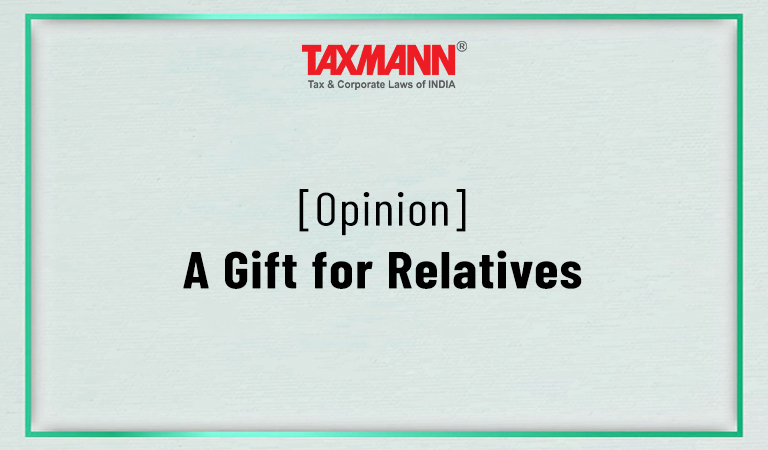[Opinion] A Gift for Relatives
- Blog|News|Income Tax|
- 3 Min Read
- By Taxmann
- |
- Last Updated on 18 November, 2022

Meenakshi Subramaniam – [2022] 144 taxmann.com 211 (Article)
One ghost said to another:
“The best part about being a ghost is that there are no relatives. When alive, the income tax department was after my life, saying that relatives who managed to send a gift through their relatives could not be accepted and heavily taxed me.”
Thankfully in a recent case [P. Srinivasan v. ITO [2022] 144 taxmann.com 141)], the Chennai Tribunal has held that if a relative like paternal uncle is unable to send a gift, his son and daughter-on-law, though not relatives, can send it, with no questions asked.
P. Srinivasan v. Income Tax Officer [2022] 144 taxmann.com 141 (Chennai-Trib.)
The assessee, a proprietor of rice mills was scrutinized u/s 143(3) on 30-12-2016. It transpired that the assessee received gift of Rs.50 Lacs from his uncle (father’s bother) Shri S. Chellapan. Accordingly, the transaction was subjected to scrutiny of Ld. AO.
Assessment Proceedings
The donor confirmed that the gift was out of love and affection for the welfare of brother’s son and his family. As per donor’s instructions, the gift was transferred through bank by his son and daughter-in-law residing at Singapore as non-resident (NRI).
However, the evidence of relationship, copy of return of income of donor was not produced and accordingly, Ld. AO opined that the capacity of the donor and the genuineness of the transactions could not be furnished. The Ld. AO also held that his uncle was nowhere involved in the transaction. Finally, invoking the provisions of sec.56 (2)(vii), Ld. AO held that though gift from close relative is not taxable but the recipient of the gift has to produce the evidences to prove the genuineness of the gift. Since the assessee received the gift directly from Bank account of uncle’s son and daughter-in-law, it should be understood that the gift was received from them only. Since the son and daughter-in-law do not fall within the definition of ‘relative’ in sec.56 (2)(vii), the gift so received would be taxable in the hands of the recipient assessee. Accordingly, the sum was added to the income of the assessee.
Aforesaid appeal by assessee for Assessment Year (AY) 2014-15 arises out of the order of learned Commissioner of Income Tax (Appeals)-1, Madurai [CIT(A)] dated 19-2-2019 in the matter of the assessment framed by Ld. Assessing Officer [AO] u/s.143(3) of the Act on 30-12-2016.
The sole ground urged before the Tribunal is about addition of gift of Rs.50 Lacs u/s 56(2)(vii) as made by Ld. AO. No other ground has been urged in the appeal.
The Ld. AR, drawing attention to the documents, assailed the impugned order confirming the addition and submitted that the facts would establish that there was constructive gift from the donor to the assessee. The Ld. Sr. DR controverted the arguments of Ld. AR and submitted that gift received by the assessee from donor is not covered under exception clause of 56(2)(vii). Having heard rival submissions, the appeal is disposed-off as under.
Appellate Proceedings
During appellate proceedings, the assessee, inter-alia, submitted that the assessee’s uncle confirmed the transaction of gift through his letter dated 05-12-2016 and the gift has been transferred by his son and daughter-in-law under his instruction for the welfare of the assessee and his family. The assessee also submitted that the ingredient of sec.68 r.w.s. 56(2)(vii) were fulfilled and the gift received from paternal uncle comes in exception clause and the term ‘relative’ include paternal uncle. Regarding financial capacity of the donor, the uncle was stated to be assessed to income tax and owned many businesses.
However, Ld. CIT(A) held that the assessee did not submit any documentary evidence to prove that the son and daughter-in-law had the capacity to make the payment of Rs.50 Lacs to the assessee. Mere making of statement by the person who falls u/s 56(2)(vii) as relative that a particular sum has been given as gift on the instruction of the said relative cannot make the sums of money received from other person as receipt of gift from the said relative. Therefore, the sum was not received from the ‘relative’ within the meaning of sec.56 (2) (vii) and accordingly, the grounds raised by the assessee were dismissed. Aggrieved, the assessee went in further appeal before the Chennai Tribunal.
Click Here To Read The Full Article
Disclaimer: The content/information published on the website is only for general information of the user and shall not be construed as legal advice. While the Taxmann has exercised reasonable efforts to ensure the veracity of information/content published, Taxmann shall be under no liability in any manner whatsoever for incorrect information, if any.

Taxmann Publications has a dedicated in-house Research & Editorial Team. This team consists of a team of Chartered Accountants, Company Secretaries, and Lawyers. This team works under the guidance and supervision of editor-in-chief Mr Rakesh Bhargava.
The Research and Editorial Team is responsible for developing reliable and accurate content for the readers. The team follows the six-sigma approach to achieve the benchmark of zero error in its publications and research platforms. The team ensures that the following publication guidelines are thoroughly followed while developing the content:
- The statutory material is obtained only from the authorized and reliable sources
- All the latest developments in the judicial and legislative fields are covered
- Prepare the analytical write-ups on current, controversial, and important issues to help the readers to understand the concept and its implications
- Every content published by Taxmann is complete, accurate and lucid
- All evidence-based statements are supported with proper reference to Section, Circular No., Notification No. or citations
- The golden rules of grammar, style and consistency are thoroughly followed
- Font and size that’s easy to read and remain consistent across all imprint and digital publications are applied




